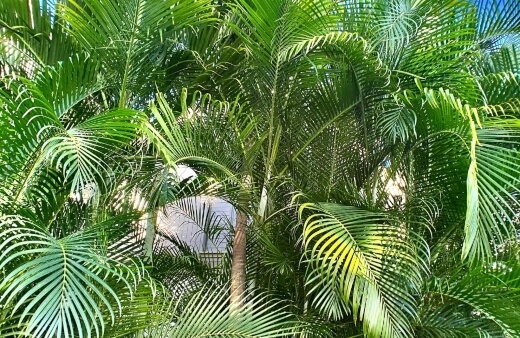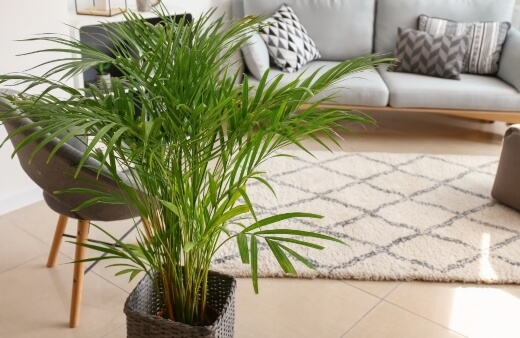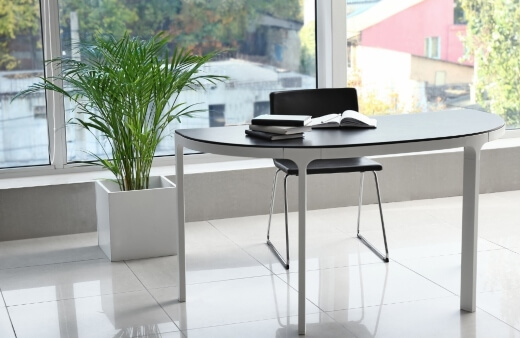Golden cane palm is a fantastic way to add flair and a holiday atmosphere to your home or patio. Considered a medium-sized tree, the golden cane palm is initially a slow-grower but, once established, will thrive, producing a year-round spectacle of feathery foliage.
Ideal for the beginner grower, here is your complete guide to growing golden cane palm.
More...
Introducing the Golden Cane Palm

Golden cane palm, Dypsis lutescens, also known as areca palm or butterfly palm, is a loose, feathered palm variety native to Madagascar.
Part of the Arecaceae family, this evergreen plant produces a fantastic gold-coloured stone fruit, for which it’s been given its name. Although unlikely to flower indoors, when it does bloom, it produces glorious panicle flowers.
Often grown as an ornamental, indoor tree, the golden cane palm has superior air-purifying qualities, making it a great option for homes, bedrooms, and offices.
When planted outdoors, this palm can grow as much as 6 to 8 metres tall. However, indoors it tends to remain a little more compact.
How to Grow Golden Cane Palm

While the golden cane palm is fairly adaptable, it is important to find the right spot to grow. Areca palms thrive in warm, humid conditions with lots of dappled or indirect light.
If growing indoors, some growers will recommend giving your areca palm some direct sunlight during the day. However, take care not to expose its delicate fronds to too much direct sun.
Should the fronds begin to yellow, you’ll know it’s getting too much exposure. Golden cane palms love a good amount of humidity, so keeping it in locations like the bathroom or near a humidifier is ideal.
Avoid keeping your palm in any drafty spots, as they won’t fare well with drastic temperature changes. A general potting soil will do quite well for this kind of palm. However, you’ll want to ensure the soil is nutrient and humus-rich.
How to Propagate Golden Cane Palm

Golden cane palms are generally available at most garden nurseries. However, it is also possible to propagating new palms from the small shoots which older plants produce.
These shoots can be easily detached and re-planted into their own pot to grow. Young plants will need to stay well-watered in the beginning growing stages.
These shoots can be removed at any point throughout the year. However, if taken in winter, it’s recommended to keep your propagated plants in a warm, well-lit area away from cold windows.
Potting or Repotting Golden Cane Palm

Potting or re-potting of golden cane palm should be done during the spring or summer months for optimal results. Younger plants should be repotted annually, whereas more established plants can be re-potted every 2 to 3 years.
When planting, simply:
- Prepare a pot, which is twice the size of the current container.
- Fill the pot halfway with a rich, organic potting mix. For younger plants, a palm potting mix is preferable.
- Place the rootball into the pot, ensuring that the top of the rootball lines up with the top edge of the pot. Backfill with the rest of the soil and pat down gently to remove any air pockets.
Keep newly planted palms well-watering but not water-logged.
Golden Cane Palm Care Tips

Areca palms can take a little neglect. Still, the most important care aspect you’ll need to pay attention to is watering. Areca palms require a balance between moist soil that’s not too wet and is able to dry out in between.
In general, only water your golden cane palm every few days once the first 3 to 5 cm of soil have dried out. In winter, you can almost cut back on watering completely. Avoid waterlogging the soil at all costs, as this can often lead to fungal diseases.
Younger plants will require a little extra water while establishing. When watering, it is recommended to remove the plant from its pot and place it into your basin or into your bathtub.
Drench the soil and allow it to drain completely before returning it to the pot. Your areca palm won’t require any pruning in your day today. However, you can cut away any damaged or yellowed leaves.
Looking for more palm tree options? See our list below:
Potential Pests and Problems
Most issues arise when these palms begin to take the strain, in winter, for example, or when the soil dries out too much.
Potential problems include:
This can be easily treated with a natural insecticide or with a strong spray of water.
Some other issues include:
Foliage and Stem Yellowing
While too much sunlight can cause foliage to be yellow, once the yellowing extends into the stem, you may have an overwatering issue. Try to cut back on how often you water or test your soil with a soil moisture meter.
Here is our review on the best soil moisture meter on the market.
Browning Foliage
Browning foliage can be caused by two factors. It could be due to a lack of adequate airflow or too little humidity. Consider keeping your areca palm in the bathroom while you shower or mulching around the base to help the soil retain moisture.
If you want more tropical plants, don't miss our growing guide for Cordyline and Frangipanis which will grow quite well with your areca palm.
Golden Cane Palm Frequently Asked Questions
Can golden cane palms grow in full sun?
These perky plants thrive in full sun to partial shade outdoors. If growing indoors, a bright location with some direct sunlight is ideal.
How tall does a golden cane palm grow?
If grown in the garden, a golden cane can grow up to around 6 to 12 metres tall with an average height of 4 metres. If grown in containers, growth will be more limited and controllable.
How often should I water a golden palm?
Once the top 5 centimetres or so of soil has dried, you can water your golden cane palm. As a general guide, these plants require watering every 5 to 7 days in the warm seasons and less in the winter period.
Are golden cane palms toxic?
This plant is considered non-toxic to pets and people.
Do golden cane palms like the wind?
These palms are very popular for growing in the Sydney region but generally, they thrive in a warm protected location rather than a cold spot that is exposed to high winds.
How long does it take for a golden cane to grow?
Considered slow-growing, this plant could take up to 28 years to reach its full height depending on the conditions.
How much space do golden cane palms need?
For screening and general planting in beds, plant them 2 metres apart for the best results.
How long do golden palms live?
These palms can live to be over 30 years old.
What can I plant under my golden cane palm?
Bromeliads and orchids make for excellent additions under most palms. Alternatively, caladiums and calatheas are also great options.
Wrapping Up Our Golden Cane Palm Grow & Care Guide
If you’re looking for other ways to create a tropical paradise within your home, you can take a look at some fantastic tropical plant options.
While tropical plants can sometimes require a little extra attention, it won’t be the case when you choose to grow an areca palm. Pick a spot with sufficient sun and keep an eye on your soil from time to time.
There your have it! Everything you need to know to grow Golden Cane Palm!

Published on January 4, 2023 by Gary Clarke
Last Updated on February 1, 2024





Hello. I am wanting to cut back heavily the big golden palms along the side of my house. If i cut all the green i just get the trunks but what about if i want to cut the trunk off the tree s – do i cut back new growth or the older wood looking trunks?
Hi Simone,
Have you got any pictures we could take a look at? I think I know what you mean, but want to be sure.
It depends on what you want to achieve really. If you’re aiming for a leafier plant lower down, then you can cut the mature trunks right to the ground and let the suckers grow up. If you want to keep the base of the plant clear, just cut back all the new growth around the bottom of the plant. It will be a regular job though, because that’s how they grow naturally.
Another long-term solution could be to cut back one or two mature trunks now, and wait a few years to do the rest. That way you can keep younger, shorter growth going.
But like I say, it depends on what the desired result is.
Best regards,
Gary Clarke